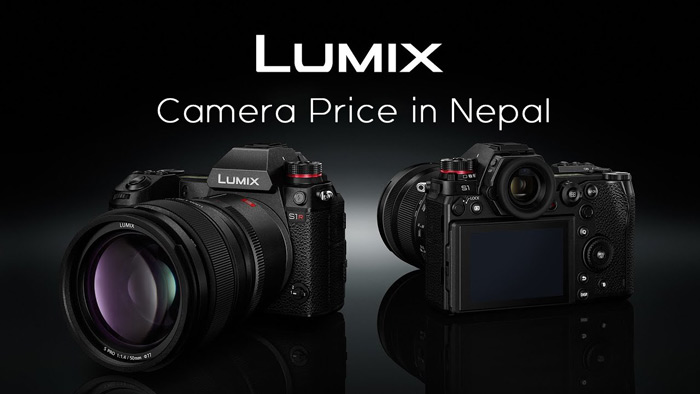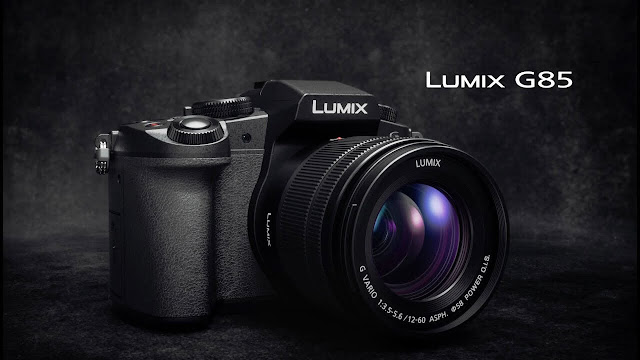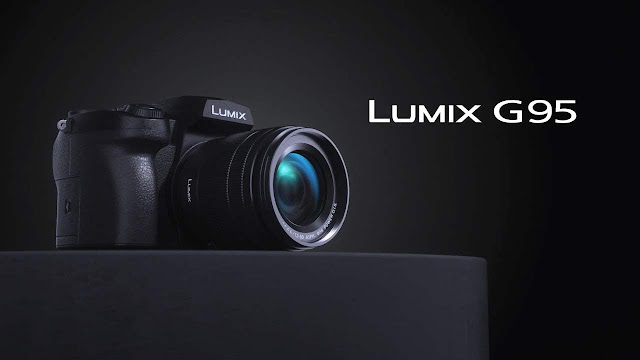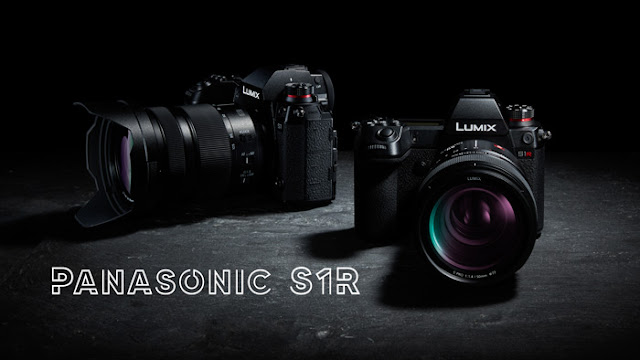
Panasonic's recent mirrorless camera model which is S series cameras
including S5 and S1R price in Nepal is much higher than the previous
models Panasonic Lumix Gh4 and Gh5 cameras. Panasonic cameras are known
for their great video features with amazing image stabilization
capability. They don't really focus on photography that much, but that
doesn't mean you can't take a picture from that camera, and also the
autofocus is not that great like the Canon Dual Pixel autofocus system,
they just have contrast-detection autofocus technology which is not that
great, It is usable for some situations but not for all.
In this article, we are going to discuss the Panasonic camera price in
Nepal including the latest S series cameras and the previous models like
Panasonic G7, G85, and G9 series which is a budget camera from
Panasonic, and also the very popular Lumix Gh4 and Gh5 cameras.
They have extremely excellent technology on the basis of a professional
camera, especially for videography. They are always on the edge of
developing their technology to improve the current camera quality.
It has never disappointed to surprise the entire camera lover and its
customers. Especially the new mirrorless cameras which come with amazing
video features like 4k 60 and great image quality without any heating
problems, unlike the Canon EOS R5 camera which shuts down after some
time, if you use the high-quality mode.
First, let's look at the Panasonic Cameras List
➦ Panasonic Lumix G7
➦ Panasonic Lumix G85
➦ Panasonic Lumix G95
➦ Panasonic Lumix GH4
➦ Panasonic Lumix GH5
➦ Panasonic Lumix S5
➦ Panasonic Lumix S1R
Panasonic Lumix G7
LUMIX G7 is one of the best and yet cheapest 4k cameras right now, which is
great f you are YouTube Creator or walk to get into filmmaking to learn all
the basic fundamentals without investing too much. It is built on the
next-generation mirrorless interchangeable lens camera standard (Micro Four
Thirds) offered by Panasonic. It is very light and compact in size if you
are planning to travel more than It might be helpful for you are carrying on
your trips.
Panasonic Lumix 4K Digital Camera DMC G7KK accepts over 24 compact lens
options built on the next-generation interchangeable lens camera (ILC)
standard (Micro Four Thirds) pioneered by Panasonic. Its “mirrorless” design
enables a lighter, more compact camera body while also offering cutting-edge
video, audio, creative controls, wireless, intelligent focusing, and
exposure technologies not possible with traditional DSLRs.

For connectivity convenience, the G7 includes a 3.5mm and 2.5mm microphone
& remote ports, USB 2.0, and a micro HDMI (Type D) terminal. It’s also
compatible with newer BUS Class UHS I/UHS II SDXC/SDHC SD cards capable of
storing high resolution 4K videos and meeting the demands of 4K Photo and
Raw mode burst shooting.
A Better Choice for High Image Quality
A 16-megapixel sensor features a next-generation intelligent image
processor that produces video and photos free from artifacts that degrade
image quality.
4K PHOTO and Video Recording
Special moments are missed because you did not press the shutter at the
right moment. LUMIX G7 featuring 4K video technology can pause and extract
that perfect photo moment in time from 4K video. 4K video provides nearly 4X times the number of pixels than Full HD
video. Video will feature superior definition and crisper detail than
those recorded in Full HD with a camcorder.
Intuitive Controls
Smaller and lighter than traditional DSLRs, yet still provides intuitive,
easy access to common functions. Easily control aperture and shutter
settings with the front and rear dials.
High-Visibility View Finder
A high-resolution (2,360k-dot) OLED Live View Finder with 10,000:1
contrast for high visibility—even under direct sunlight. Plus, the
tilt/swivel touch display adjusts for optimum clarity.
Unwire Your Creativity via Wi-Fi
The Panasonic Image App connects by Wi-Fi to the camera and grants
control over various functions via a smartphone or tablet device.
Expandability Options
Expand with optional accessories like the DMW-FL580L External Flash and
DMW-MS2 Stereo/Shotgun Microphone.
Panasonic Lumix G85
The Panasonic Lumix DMC-G85 is the bigger brother of the last-gen Lumix
G7 model and It is a little bit better in every area as compare to the
last model. It is an SLR-style mid-range mirrorless camera. It features
4K video capture, 2nd-generation 5-axis image stabilization, and a 16MP
Four Thirds sensor with no optical low pass filter. It is also sold as
the Panasonic G80, G81, and G8, depending on the different markets and
countries.
Though Panasonic has not come outright and said it, the G85 is the
successor to the G7. More a refinement than something new entirely, both
cameras share seemingly identical bodies and offer twin control dials,
plenty of customizable buttons and fully articulating touch
interfaces.

For current users, I highly suggest doing the following:
- Go to the menu --> Setup --> beep (page 2) --> Turn off the beep volume and E shutter volume
- This was a huge annoyance for me at first, and I was relieved to find it in the settings.
- Battery saving options are also within page 2 of a setup such as Live View Mode (30fps), Monitor Luminance, and Economy.
Pros:
- Stills quality is very nice and sharp, even from the 12-60mm kit lens. Image quality and bokeh are stunning when paired with the 25mm f1.7. The dual IS is really good for stills and even more amazing in the video. Two custom settings within the dial are really helpful for saving your own shooting modes. I personally save Shutter-priority video moves to these in different recording formats (i.e. 4k30fps, FHD60fps).
- Weather sealed - Not much to say here other than, great!
- Coming from a Nikon APSC camera, I am amazed at how light and robust the mirrorless form factor is. There is little fatigue in carrying it in your hands all day. The LCD screen that allows a full swivel is really neat for selfies/vlogging.
- Finally... the video. Most buyers are probably here b/c of this and yes. it does not disappoint. The detail is amazing! BUT, the real shocker is the image stabilization. When paired w/ dual IS and E-stabilization turned on, the video is practically gliding (especially @ wider angles - 12mm).
Cons:
- It's only up to 16MP stills, though I still find the image quality to be very good even when an image has been cropped in edits.
- I found that the image is a bit noisy at higher iso (6400 and above), though this is not really a bother to me. I find that it gives it a natural feel to lowlight shots. You can always dial it down with a bit of NR in Lightroom and other software.
- A slight crop to the 4k video recording.
- This was not a con for me, but others may think it. There's a lot to learn w/in the settings of this camera. Take the time to read the advanced handbook. Experiment!
Panasonic Lumix G95
The Panasonic Lumix DC-G95 is another solution that comes with great features if you are planning to capture great content. G90 and G91 sold outside
North America, which uses a different type of display. It is a mid-range
20MP Micro Four Thirds mirrorless camera. Panasonic says it's designed
to be equally adept at both stills and video, though we don't wholly
agree.
It offers an extensive degree of direct control, a flip-out touchscreen,
and in-body stabilization: a combination that's unusual at this point in
the market. This is enough to make it an attractive enthusiast stills
camera but a significant video crop undermines its video-making
credentials.

Pros of Panasonic G95 :
- The flexible screen can be easily adjusted to almost any format you want. You can make the screen face outwards or to the back. What I really like about this is that it felt very sturdy/stable, regardless of where you put the screen at.
- The menu system on this camera is clear and direct. I didn’t feel overwhelmed when scattering through the menu. Very organized and not at all intimidating.
- You can customize almost any of the camera controls you want. I didn’t toy with this feature because it's really based on those who already have a system when shooting professionally.
- 4k (30, 25, and 24fps) shoots work like a charm, and yes unlimited recording is allowed! I’ve heard they’re selling a version in Europe that will only allow 30 minutes per shoot. This could be wrong but it’s something you should know if it’s right (Also, you can film in 1080 60fps).
- The dials and the control buttons all feel firm and tight. Nothing on this is loose or wiggling.
- Shooting indoors, I was impressed with how well the auto white balance was able to perform. The room I tested in had a yellow cast light bulb that made a warm lighting effect. This feature clears this issue up.
- The stabilization is well made in this camera (a Dual IS system with 5-axis image stabilization). I know this will be a benefit for those who want to shoot at a slower shutter speed, therefore keeping the ISO speed down.
- The buffer delay is nonexistent. It takes maybe 1 second to store your image.
- A big thumbs up when you see that the camera has a built-in microphone and headphone sockets on the side. It’s on the top of the camera, which was a brilliant place to put it because the LCD screen can be moved freely without being blocked by the mic jack.
- Face and eye detection work really well. In a crowded mall, I was able to focus directly on my friend.
- Built-in pop-up flash. No need to buy an extension because this flash also has numerous settings depending on your shot.
- The “Easy Touch” feature is the second-best mode on this camera. It lets you erase unwanted objects in an image, using the camera, without having to edit them on a computer. For those who use Photoshop or Illustrator, this is a Godsend. To do this work without even using your computer.
- You can choose to use either a mechanical or electronic shutter. The choice is yours.
- The screen is responsive, with no delay, and I found it very useful to set the focus point while using the screen as a guide.
- The weatherproof/ dustproof design gives this camera a great grip, regardless of hand size.
- The layout is built in a way that you can use this with one hand (small and compact). If you’re a vlogger then this was the news you were looking for.
Cons of Panasonic G95 :
- Battery life isn’t great. Up to 290 shots and you then have to charge it up. It does have a power-saving mode that can bring it up to 900 shots.
- Putting the camera up to your eye does create an issue with the screen below. On numerous occasions, it was very easy to brush the screen with my hand and the focus point, that I originally put, was changed.
- Micro USB connection (not USB Type-C). This is a Pro as well because you can charge it without a battery replacement, but a Con because it’s a Micro USB connection.
- The electronic viewfinder occurs indoors, low light, which results in a noticeably grainier picture.
- You’re able to combine multiple images into one action shot. Have no idea why you just film it (it’s literally the same feature).
- For more of the camera pro, the Micro Four Thirds sensor is small, but this doesn't seem to harm its performance.
- A single memory card slot. No extension options.
- Note that this has a smaller sensor, but it does not put it at a disadvantage. Still, you need to know that there are some competitors (ex: Sony) that have cameras that provide a bigger sensor and more megapixels for the same money.
- I’ve noticed some noise performance in the camera at higher ISO speeds.
Bottom Line:
Reviewing cameras are always difficult because the end result is what “you” see in a picture/video. It’s the same as buying a car or a house. You need to test it out yourself before saying “yes, I’ll buy it.” This is a must if you don’t really know about the mechanics of a camera because there might be something on this camera that doesn’t feel right to you.
But if I had to summarize it, it’s a great camera that fits all beginners and pros. The software is well made and is still compact enough to put it in your backpack. I see this more for vloggers but for those who live in a sports world that need 4k 60fps, this camera doesn’t have it. A simple menu layout that makes it easy for beginners, and the indebt customization and modes that makes it feel like home for a professional.
Panasonic Lumix Gh4
The Panasonic Lumix DMC-GH4 4K Mirrorless Micro Four Thirds Digital
Camera is a true hybrid camera designed for both professional photo and
video use. It features a 16.05-megapixel Digital Live MOS sensor and a
4-CPU Venus Engine, capable of capturing high-resolution JPEG and RAW
stills, as well as UHD 4K 3840x2160 30p/24p and cinematic DCI 4K 4096x2160
video at 24p.
Like its predecessor, the GH4 features a weather-sealed magnesium alloy
body, while offering increased resolution on both the OLED monitor and
electronic viewfinder. It also features built-in Wi-Fi with NFC
technology, in-camera creative controls, and high-speed 49-point autofocus
in both photo and video mode. Use within the communication range of the
device to be connected.

The GH4 boasts newly developed high-precision, high-speed dual OLED
(Organic Light-Emitting Diode) displays of 2,359K-dot LVF (Live View
Finder) and 1,036K-dot rear monitor. Both the LVF and rear monitor adopt
an OLED to achieve high-speed response with minimum time lag while
enhancing the resolution. Notably, the OLED for the LVF in GH4 boasts
10,000:1 high contrast for superior color reproduction.
To be tough enough to withstand heavy field use, the main structure of
the GH4 is composed of a magnesium alloy full die cast front/rear frame.
It also features splash / dustproof construction by sealing every joint,
dial, and button. The shutter unit allows a max. 1/8000 shutter release
and is also redesigned to be even more durable for approx. 200,000
actuations.
Panasonic Lumix Gh5
The Panasonic Lumix DC-GH5 is the fifth in the company's
industry-changing video and stills 'hybrid' lineup. With its 20MP Four
Thirds sensor and deep video-centric feature set, it looks likely to
pick up where the GH4 left off as a favorite of indie filmmakers and
photographers whose interests venture into the realm of motion picture
work.
The GH5's feature set moves on suitably far from its predecessor that
the company says the GH4 will remain in its lineup as a lower-cost
option for users who don't need the additional capability that the GH5
brings.

For many users, the addition of in-body stabilization and 4K video
without cropping might be enough to make the camera a worthwhile
upgrade, but Panasonic has revised and improved almost every aspect of
the camera's behavior and performance.
Key Features
- 20MP Four Thirds sensor (no OLPF)
- 5-axis in-body image stabilization system with 'Dual IS 2' support
- All 4K footage taken using the full width of sensor (oversampled from 5.1K footage)
- Internal 4K/30p 10-bit 4:2:2 video capture
- 4K/59.94p and 50p shooting with 10-bit 4:2:2 output or 8-bit, 4:2:0 internal recording
- 1080 video at up to 180p, enabling 7.5x slow-motion
- 9 fps shooting with continuous autofocus
- Advanced DFD autofocus
- Dual UHS-II card slots (V60 ready)
- Autofocus point joystick
- 802.11ac Wi-Fi, NFC, and Bluetooth
- Pre-configurable rack focus mode
- Waveform and vectorscope monitors
- Paid upgrade to enable V-LogL video capture with LUT-based preview display
Panasonic Lumix S5
Panasonic went big with its first-generation Lumix DC-S1 full-frame
mirrorless camera, both in size (it's as hefty as some SLRs) and price,
positioning it around $2,500, toward the high-end of the range for a
24MP model. It's targeting a more entry-level market with the Lumix
DC-S5 ($1,999.99, body only), but instead of cutting back on features,
the S5 is a bit more capable, offering improved video features and
better autofocus. It's a great entry point for full-frame imaging and a
winner of our Editors' Choice award.

LUMIX S5 is a hybrid full-frame mirrorless camera that achieves both
excellent performance in photo/video in a compact body designed for
aspirational content creators.
At the heart of the camera, the LUMIX S5 contains a 24.2-megapixel
35mm full-frame CMOS sensor that boasts a wide dynamic range and high
sensitivity performance made possible by sufficient light
condensation. The LUMIX S5 further realizes recording maximum ISO51200
crystal-clear high sensitivity video with the adoption of the Dual
Native ISO technology.
As a pioneer of photo/video hybrid mirrorless cameras, the LUMIX has
the largest lineup of cameras that record 4K 10-bit video*2. As the
latest member of the family, the LUMIX S5 is capable of 4K 60p/50p
4:2:0 10-bit, and 4K 30p/25p 4:2:2 10-bit internal recording. It is
also capable of 4K 60p/50p 4:2:2 10-bit HDMI output. For 4K 30p/25p
4:2:0 8-bit internal recording, there is no time limit.
The LUMIX S5 boasts high-speed, high-precision AF in both photo
shooting and video recording that is made possible with advanced
deep-learning technology featuring real-time detection of the
subject’s type and parts such as human eye, face, head, and body.
Key Takeaways
- Includes many of the video features found on the more expensive S1H, though not the highest bit rate codecs
- Updates to Panasonic's DFD autofocus system promise improved subject recognition and speedier AF calculations
- Multi-shot 96MP high res mode can output JPEG and Raw
- Live view composite mode opens the door to some creative photo opportunities.
Panasonic Lumix S1R
The Panasonic LUMIX S1R yields unprecedented image quality with
high resolution, rich gradation, and superior color reproduction. A
high-speed, high-precision AF system based on advanced control
technology over the lens, the sensor, and the new Venus Engine
enable the user to capture the precise moment in the finest detail.
The LUMIX S1R also boasts industry-leading video recording
performance (4K 60p/50p), intuitive control, a rugged design for
heavy field use, durability, and expandability.

The Panasonic S1r is a mirrorless camera with a 47-megapixel
sensor. As such, it provides highly detailed pictures which can be
enlarged to wall-size prints. With all these pixels, one can crop
the image for the perfect composition.
The camera is about the size and weight of the digital SLR, and it
is ideal for the meticulous worker who takes time to compose his
photographs. Its autofocus system works best when dealing with
static subjects. For landscape and portraiture photography, this
is fine. For recording sporting events with fast action, the
continuous focus is not as reliable as those found on cameras such
as the Sony a7 III, the Nikon F-series, or the Canon EOS cameras.
For those who wish to use manual focusing, this camera is almost
perfect. With its kit lens, there are several focusing aids. A
portion of the image can be enlarged to see the most delicate
details for focusing, and a color fringe can be projected on edges
when they are in focus. I was impressed with the viewfinder. It
shows the distance of the subject and the depth-of-field for a
given aperture. For old-timers, this allows them to set the
hyperfocal distance on a lens. This setting is invaluable when the
goal is to maximize the depth of field.
This camera is ideal for scientific work. It can be made to
operate in a vibration-free mode. With such a stable platform,
this ensures the sharpest obtainable pictures when the camera is
mounted on either a telescope or a microscope.
PROS
- Excellent 47MP full-frame sensor.
- 5-axis sensor stabilization.
- Big, sharp EVF.
- Good control system.
- Backlit control buttons.
- Protected from dust and splashes.
- Top information LCD.
- 4K video at up to 60fps.
CONS
- More expensive than competitors.
- Obnoxiously heavy.
- Contrast focus limits tracking speed and burst rate.
- Limited lens selection.
Panasonic Lumix Camera Price List In Nepal
| Model | Price in Nepal |
| Panasonic Lumix G7 | Rs. 60,000 |
| Panasonic Lumix G85 | Rs. 72,990 |
| Panasonic Lumix G95 | Rs. 94,990 |
| Panasonic Lumix Gh4 | Rs. 180,900 |
| Panasonic Lumix Gh5 | Rs. 224,990 |
| Panasonic Lumix S5 | Rs. 235,590 |
| Panasonic Lumix S1R | Rs. 478,900 |
Also, Read:










No comments:
Post a Comment